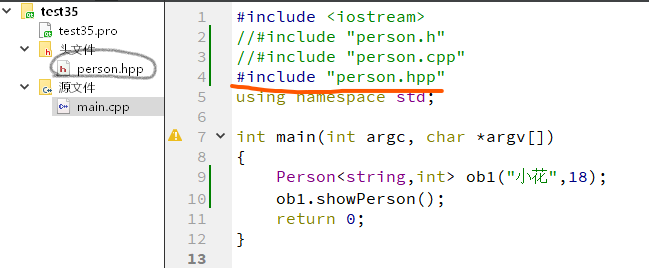一、类模板(续day18)
1.1 类模板的成员函数在类外实现
1
2
3
4
5
6
7
8
9
10
11
12
13
14
15
16
17
18
19
20
21
22
23
24
25
26
27
| template<class T1,class T2>
class Person{
public:
T1 name;
T2 age;
public:
Person(T1 name,T2 age);
void showPerson(void);
};
template<class T1, class T2>
Person<T1,T2>::Person(T1 name, T2 age)
{
this->name = name;
this->age = age;
cout<<"有参构造"<<endl;
}
template<class T1, class T2>
void Person<T1,T2>::showPerson()
{
cout<<"name:"<<this->name<<",age:"<<this->age<<endl;
}
void test01(){
Person<string,int> ob1("小花",18);
ob1.showPerson();
}
|
运行结果:
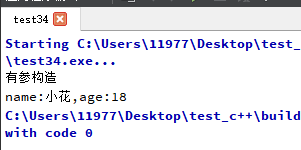
1.2 类模板源文件与头文件分离
1.2.1 源文件与头文件分离产生的问题
perosn.h
1
2
3
4
5
6
7
8
9
10
11
12
13
14
15
16
| #ifndef PERSON_H
#define PERSON_H
template<class T1,class T2>
class Person
{
public:
T1 name;
T2 age;
public:
Person();
Person(T1 name,T2 age);
void showPerson();
};
#endif
|
person.cpp
1
2
3
4
5
6
7
8
9
10
11
12
13
14
15
16
17
18
19
20
21
22
23
| #include "person.h"
#include <iostream>
using namespace std;
template<class T1,class T2>
Person<T1,T2>::Person()
{
cout<<"无参构造函数"<<endl;
}
template<class T1,class T2>
Person<T1,T2>::Person(T1 name,T2 age)
{
this->name = name;
this->age = age;
cout<<"有参构造函数"<<endl;
}
template<class T1,class T2>
void Person<T1,T2>::showPerson()
{
cout<<"name:"<<this->name<<",age:"<<this->age<<endl;
}
|
main.cpp
1
2
3
4
5
6
7
8
9
10
| #include <iostream>
#include "person.h"
using namespace std;
int main(int argc, char *argv[])
{
Person<string,int> ob1("小花",18);
ob1.showPerson();
return 0;
}
|
运行结果:

结果分析:因为类模板会进行两次编译,第一次是类模板本身编译,第二次是在类模板的成员调用的时候类型确定了,会以确定的类型再一次进行编译。由于C++/C 是独立文件编译的。如果类模板的.cpp和.h分文件,会造成第二次编译出错,找不到在.cpp中对类的定义。解决办法如下。
1.2.2 解决办法
- 1、将main.cpp中的include<person.h>替换为include<person.cpp>,因为 .cpp中也包含的.h,相当于都有了,没有分离。但是include标准是包含头文件,基本不会包含.cpp
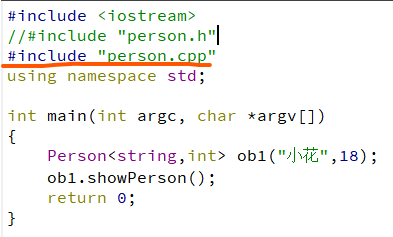
person.hpp
1
2
3
4
5
6
7
8
9
10
11
12
13
14
15
16
17
18
19
20
21
22
23
24
25
26
27
28
29
30
31
32
33
34
35
36
37
38
39
| #ifndef PERSON_H
#define PERSON_H
template<class T1,class T2>
class Person
{
public:
T1 name;
T2 age;
public:
Person();
Person(T1 name,T2 age);
void showPerson();
};
#include <iostream>
using namespace std;
template<class T1,class T2>
Person<T1,T2>::Person()
{
cout<<"无参构造函数"<<endl;
}
template<class T1,class T2>
Person<T1,T2>::Person(T1 name,T2 age)
{
this->name = name;
this->age = age;
cout<<"有参构造函数"<<endl;
}
template<class T1,class T2>
void Person<T1,T2>::showPerson()
{
cout<<"name:"<<this->name<<",age:"<<this->age<<endl;
}
#endif
|
main.cpp
1
2
3
4
5
6
7
8
9
10
11
12
| #include <iostream>
#include "person.hpp"
using namespace std;
int main(int argc, char *argv[])
{
Person<string,int> ob1("小花",18);
ob1.showPerson();
return 0;
}
|
运行结果:
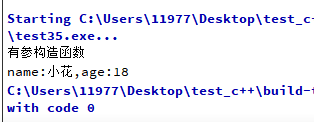
1.3 类模板的强化训练
设计一个数组模板类MyArray,完成对不同类型元素的管理。
myarray.hpp
1
2
3
4
5
6
7
8
9
10
11
12
13
14
15
16
17
18
19
20
21
22
23
24
25
26
27
28
29
30
31
32
33
34
35
36
37
38
39
40
41
42
43
44
45
46
47
48
49
50
51
52
53
54
55
56
57
58
59
60
61
62
63
64
65
66
67
68
69
70
71
72
73
74
75
76
77
78
79
80
81
82
83
84
85
86
87
88
89
90
| #ifndef MYARRAY_HPP
#define MYARRAY_HPP
#include <iostream>
using namespace std;
template<class T>
class MyArray{
private:
T *addr;
int capacity;
int size;
public:
MyArray();
MyArray(int capacity);
~MyArray();
MyArray(const MyArray &ob);
void push_back(const T &val);
void showMyArray();
};
template<class T>
MyArray<T>::MyArray()
{
this->addr = nullptr;
this->capacity = 0;
this->size = 0;
cout<<"无参构造函数"<<endl;
}
template<class T>
MyArray<T>::MyArray(int capacity)
{
this->addr = new T[capacity];
this->capacity = capacity;
this->size = 0;
cout<<"有参构造函数"<<endl;
}
template<class T>
MyArray<T>::~MyArray()
{
if(this->addr != nullptr){
delete [] this->addr;
this->addr = nullptr;
}
cout<<"析构函数"<<endl;
}
template<class T>
MyArray<T>::MyArray(const MyArray &ob)
{
this->addr = new T[ob.capacity];
int i = 0;
while (i<ob.size) {
this->addr[i] = ob.addr[i];
i++;
}
this->capacity = ob.capacity;
this->size = ob.size;
cout<<"拷贝构造函数"<<endl;
}
template<class T>
void MyArray<T>::push_back(const T &val)
{
if(this->size >= this->capacity){
cout<<"数组已满"<<endl;
return;
}
this->addr[this->size] = val;
this->size++;
}
template<class T>
void MyArray<T>::showMyArray()
{
int i = 0;
for(i = 0; i < this->size; i++){
cout<<this->addr[i]<<" ";
}
cout<<endl;
}
#endif
|
main.cpp
1
2
3
4
5
6
7
8
9
10
11
12
13
14
15
16
17
18
19
20
21
22
23
24
25
26
27
28
29
30
31
32
33
34
35
36
37
38
39
40
41
42
43
44
45
46
47
48
49
50
51
52
| #include <iostream>
#include "myarray.hpp"
#include <string>
using namespace std;
class Person{
private:
string name;
int age;
public:
friend ostream& operator <<(ostream& out,Person &ob);
Person(){
cout<<"Person默认构造函数"<<endl;
}
Person(string name,int age){
this->name = name;
this->age = age;
cout<<"Person有参构造函数"<<endl;
}
};
ostream& operator <<(ostream& out,Person &ob){
out<<"name="<<ob.name<<",age="<<ob.age;
return out;
}
void test01(){
MyArray<int> ob1(10);
ob1.push_back(1);
ob1.push_back(2);
ob1.push_back(3);
ob1.push_back(4);
ob1.showMyArray();
MyArray<string> ob2(10);
ob2.push_back("1");
ob2.push_back("b");
ob2.push_back("c");
ob2.push_back("hello world");
ob2.showMyArray();
MyArray<Person> ob3(10);
ob3.push_back(Person("小花",19));
ob3.push_back(Person("小明",15));
ob3.push_back(Person("小王",16));
ob3.showMyArray();
}
int main(int argc, char *argv[])
{
test01();
return 0;
}
|
运行结果:
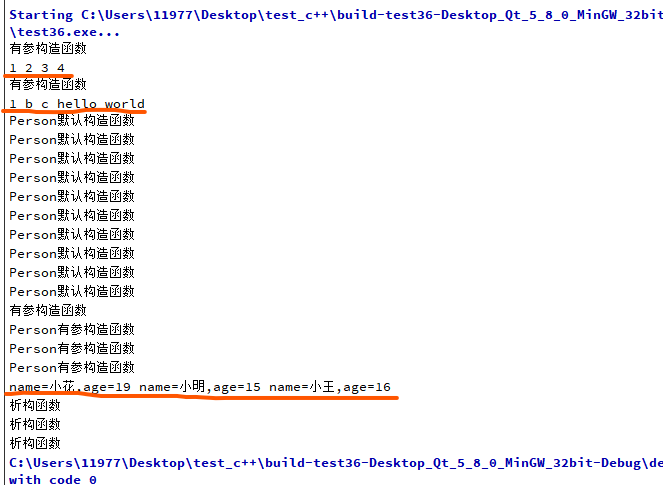
1.4 类模板与友元
1
2
3
4
5
6
7
8
9
10
11
12
13
14
15
16
17
18
19
20
21
22
23
24
25
26
27
28
29
30
31
32
33
34
35
36
37
38
39
40
41
42
43
| #include <iostream>
using namespace std;
template<class T1,class T2> class Person;
template<class T1,class T2> void printPerson2(Person<T1,T2> &ob);
template<class T1,class T2>
class Person{
private:
T1 name;
T2 age;
public:
Person(T1 name,T2 age);
friend void printPerson1(Person<T1,T2> &ob){
cout<<"name="<<ob.name<<",age="<<ob.age<<endl;
}
friend void printPerson2<>(Person<T1,T2> &ob);
};
template<class T1,class T2>
void printPerson2(Person<T1,T2> &ob){
cout<<"name="<<ob.name<<",age="<<ob.age<<endl;
}
template<class T1,class T2>
Person<T1,T2>::Person(T1 name,T2 age){
this->name = name;
this->age = age;
cout<<"Person有参构造"<<endl;
}
int main(int argc, char *argv[])
{
Person<string,int> ob("小花",18);
printPerson1(ob);
printPerson2(ob);
return 0;
}
|
运行结果:

==注意:==
当友元函数在类外定义时,是有讲究的 有了templete printPerson2是一个模板函数 在类中声明的时候需要告诉编译器(加<>) 该友元函数是一个模板函数;而且需要将void printPerson2(Person<T1,T2> &ob)在类中声明之前,在类外在声明一次,不然编译器编译到类中声明时编译器找不到模板函数会报错;然后这时候编译器又找不到Person类,所以还要在前面声明一下Person类。看上面代码就懂了。



